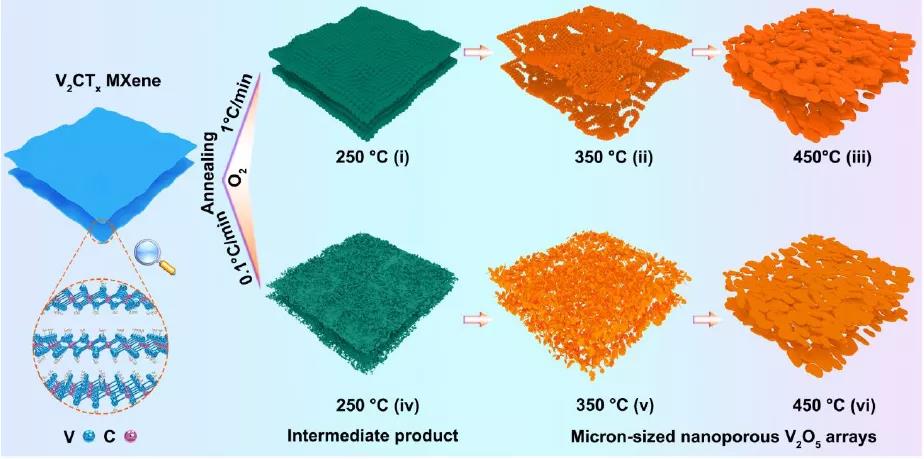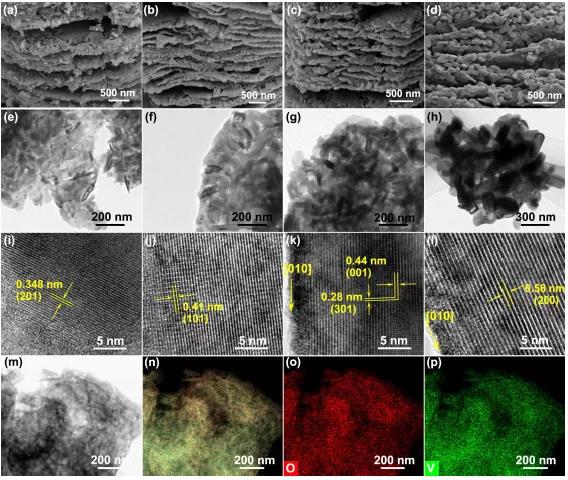Associate Professor Feng Jinkui of Shandong University: High-performance MXene-based zinc / potassium battery
QQ Academic Group: 1092348845
Detailed
High-performance negative electrodes in various rechargeable batteries are indispensable. V 2 O 5 is suitable for a variety of battery negative electrodes due to its large theoretical capacity, abundant reserves, and good safety performance. It has broad application prospects. However, the irreversible phase transition and slow ion diffusion limit its research progress.
Achievements
Recently, Shandong University ‘s vice Pingjin Kui Jiaoshou in the top international journal Chemistry of Materials published entitled " Micron-Sized nanoporous Vanadium pentoxide Arrays for High-Performance Gel Potassium and Zinc-the Ion Batteries Batteries " papers. Using V 2 CT x MXene as raw material, a nanopore V 2 O 5 array with adjustable morphology was prepared by one-step annealing method . Control the composition and structure of V 2 CT x MXene by adjusting the reaction time . The effects of annealing conditions on the crystallinity, microstructure and electrochemical performance of V 2 O 5 were further discussed . The resulting V 2 O . 5It has a unique two-dimensional porous structure and pseudocapacitive effect, which ensures high ion accessibility, excellent structural stability and fast charge transfer. Thus, zinc ion battery which exhibits higher capacity (mA 200 is G -1 cycles 400 after the secondary still up 358.7 mAh G -1 ) , excellent rate characteristics (G 8000 mA -1 when 250.4 mAh G -1 ) long-term and stable cycling capability (2000 mA G -1 cycles 3500 times for 279 mAh G -1 ) . Through quantitative kinetic analysis, the mechanism of zinc storage enhancement was discussed. In addition, the V 2 O 5 negative electrode also exhibits improved potassium storage performance. This work provides a potentially universal method for manufacturing high-performance MXene -based electrodes for next-generation battery systems .

Figure 1 Schematic diagram of the preparation of V 2 O 5 at different annealing temperatures .

Figure 2 V 2 CT x chemical structure after different annealing temperatures.

Figure 3 V 2 CT x morphology after different annealing temperatures.

Figure 4 Electrochemical performance of a zinc ion battery with a negative electrode of V 2 O 5 .

Figure 5 Electrochemical kinetic analysis.

Fig. 6 Electrochemical performance of potassium ion battery with negative electrode of V 2 O 5 .
in conclusion
A one-step annealing method was used to design and synthesize the micron-scale nanopore V 2 O 5 array with adjustable morphology , which was used in zinc ion and potassium ion batteries. Zinc ion battery which exhibits higher capacity (mA 200 is G -1 cycles 400 after the secondary still up 358.7 mAh G -1 ) , excellent rate characteristics (G 8000 mA -1 when 250.4 mAh G -1 ) , and stable the long-term cycling capacity (2000 mA G -1 cycles 3500 times for 279 mAh G -1 ) . Through quantitative kinetic analysis, the mechanism of zinc storage enhancement was discussed. This work provides a new idea for manufacturing high-performance MXene -based electrodes for a new generation of battery systems .
Original link:
https://pubs.acs.org/doi/abs/10.1021/acs.chemmater.0c00787
Source of information: 2D material Frontier
- Previous: Chinese scholars have
- Next: MXene breakthrough: Na


 mxene academic
mxene academic
